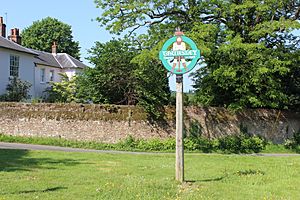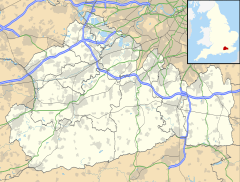Thursley facts for kids
Quick facts for kids Thursley |
|
|---|---|
 Thursley village green and village sign |
|
| Area | 19.85 km2 (7.66 sq mi) |
| Population | 651 (Civil Parish 2011) |
| • Density | 33/km2 (85/sq mi) |
| OS grid reference | SU9040 |
| Civil parish |
|
| District | |
| Shire county | |
| Region | |
| Country | England |
| Sovereign state | United Kingdom |
| Post town | Godalming |
| Postcode district | GU8 |
| Dialling code | 01252 |
| Police | Surrey |
| Fire | Surrey |
| Ambulance | South East Coast |
| EU Parliament | South East England |
| UK Parliament |
|
Thursley is a lovely village in southwest Surrey, England. It is located west of the main A3 road and sits between the towns of Milford and Hindhead. A smaller nearby area, called a hamlet, is known as Bowlhead Green. To the east of Thursley is the village of Brook. In the southern part of the area, you can find the Greensand Ridge, a line of hills that reaches its highest point near Punch Bowl Farm and the famous Devil's Punch Bowl.
Contents
Thursley's Past: A Look at History
Thursley's name comes from an old language called Old English. It means "Thunor's lea," which was a clearing in a forest belonging to the god Thunor. Thunor was a god worshipped by people long ago, similar to the Norse god Thor. This suggests that Thursley might have been a special place for worship.
There's a rocky spot near the village called Thor's Stone. People in the Victorian times thought this was a place where Thunor was worshipped. This stone was first mentioned in ancient Saxon times. It was said to be "near Peper Harow," another nearby area with old pagan connections. We're not completely sure which exact stone this refers to today. Some think it's the rocky outcrop, while others believe it's an old Celtic boundary stone found near Pudmore pond.
The Village Church
The village has a small church called St Michael and All Angels. It has a beautiful Anglo-Saxon font, which is a basin used for baptisms. The church also has two original Anglo-Saxon windows in the chancel, the part of the church near the altar. These windows are special because they still have their original wooden frames. The church's small wooden bell tower is supported by a very strong, old timber frame. Nearby, you can see the remains of a very old, twisted tree. In the churchyard, there's a special gravestone for an Unknown Sailor.
Military Camps in Thursley
Thursley has been home to several military camps over the years. From 1922 to 1957, there was Thursley Camp, which was later renamed Tweedsmuir Camp in 1941. This camp housed soldiers from Britain, Canada, and America at different times. During World War II, on November 7, 1942, the German air force, called the Luftwaffe, bombed the camp. After the war, the camp was used to provide homes for people from Poland who had been displaced by the war. To the west of the village, there was another camp called Houndown Camp, used by the British Royal Marines.
Thursley's Landscape: Geography and Nature
The northern part of Thursley is mostly the Thursley Nature Reserve. This area is a sandy and sometimes marshy Site of Special Scientific Interest (SSSI). This means it's a special place protected for its wildlife and natural features. It's part of a larger area of open land, including Thursley Common and Witley Common.
On the other side of the main A3 road is Bowlhead Green, another part of Thursley. There's an underpass path that connects these two areas, which is part of the Greensand Way walking trail. The two areas are also linked by one of the biggest junctions of the A3 road in the north of the parish. This junction helps the Ministry of Transport get to the restricted land further north, known as Hankley Common.
Wildlife in Thursley: A Natural Haven
Thursley Common is a very important natural area. It's a national nature reserve and an SSSI. It's one of the last remaining areas of lowland peat bog in southern Britain. At 350 hectares, it's also one of the largest pieces of heathland left.
This area is a fantastic home for many different animals and plants. It's especially known for its many types of dragonflies and damselflies. You can also find other rare species here, like the woodlark and the Dartford warbler.
Sadly, Thursley Common has experienced large fires. In July 2006, during a very hot period in southern England, about 60% of the common burned. In May 2020, another fire affected 150 hectares of the common.
Famous People from Thursley
Many interesting people have lived in or had connections to Thursley:
- James Anderson was an actor.
- Mary Bennett was the head of St Hilda's College, Oxford, a famous university college.
- Monica Edwards was a writer who wrote her "Punch Bowl Farm" book series while living at Punch Bowl Farm from 1947 to 1970.
- H. A. L. Fisher was a historian and a Liberal politician. He was in charge of education in the government from 1916 to 1922. He was also the head of New College, Oxford.
- Lettice Fisher started a charity called the National Council for the Unmarried Mother and her Child, which is now known as Gingerbread. Both Lettice Fisher and Mary Bennett lived and died at Rock Cottage in Thursley.
- Sir Edwin Lutyens was a famous architect who grew up in the village. Some of his first buildings are in Thursley. He used modern materials like concrete but also loved traditional building styles. He was inspired by the local buildings, especially their wooden parts, windows, and roofs.
- Sir Roger Stevens was a diplomat, which means he represented his country in other nations. He was also the Vice-Chancellor of the University of Leeds.
- Roger Taylor (Queen drummer), the drummer for the famous band Queen, lived at Millhanger from 1979 to 2003.
- Margaret Louisa Woods was a writer.
Images for kids
-
Memorial to Admiral of the Fleet Bruce Fraser, 1st Baron Fraser of North Cape at St Michael and All Angels Church in Thursley
-
Larger houses in Thursley are where the Greensand Ridge commences
-
Rich and fertile soil supports arable farming, or grass-supported dairy farming as shown







